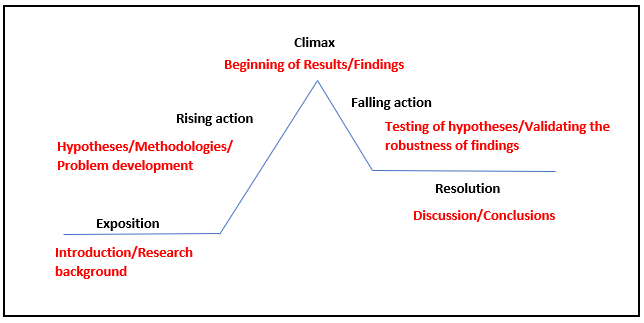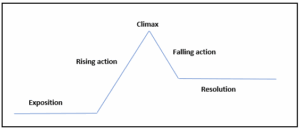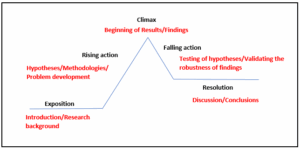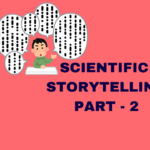Can Research Articles Follow a Story Arc? Freytag’s Pyramid for Effective Storytelling in Scientific Papers

Remember the bedtime stories told by your grandmother in your childhood? They kept you hooked throughout the narrative and you always wanted more! What if you could do the same with your research papers? Instead of simply reporting your findings, how about telling a story to take your readers through the journey of your research? Well, that’s where Freytag’s Pyramid can be your best companion! Read on to learn how this powerful storytelling technique can transform your research paper writing.
What is Freytag’s Pyramid?
Back in the 19th century, Gustav Freytag developed a structured framework for dramatic storytelling. He divided the different stages of a play into a five-act narrative:
1. Exposition: This is where the story begins, setting the background and introducing the characters. In your research paper, this will be the Introduction section that sets the context of your study.
2. Rising action: In the second act, the story builds on the main conflict or problem. This is what the Methods section does in your research paper—it presents the research hypotheses and methodologies, laying a foundation for further analysis.
3. Climax: Here comes the most pivotal point in the story! The turning point that makes the audience gasp! Well, in your research paper, it’s your results and key findings that enlighten the readers of a significant shift in the narrative.
4. Falling action: Things start to settle down and loose ends are slowly tied up after the exciting turn of events in the climax. In research, the latter part of the Results section plays this role—your hypotheses are tested and the findings are validated for robustness.
5. Resolution (or Dénouement): Well, the story has reached its conclusion, either giving clarity on the conflicts raised or leaving room for interpretation. By now you must have realized that the section that corresponds to this final act is the Discussion! This is where you educate your readers about the implications of your research findings and highlight future research directions.
And with that, we have come to the end of our story—I mean, research paper!
Implementing Freytag’s Pyramid for Scientific Writing
While Freytag’s Pyramid is commonly used for fictional stories or plays, it can be highly effective in writing research papers as well. Here’s an example of how this five-act story structure can be applied to academic writing.
Let’s consider a study debating the effectiveness of AI in various aspects of the education setting. Here’s how you can structure it using 5 stages of Freytag’s Pyramid:
1. Exposition (Introduction)
Background and context
- Explain the rise of AI in education (adaptive learning, AI tutoring tools, automated grading, etc.).
- Highlight the importance of evaluating the effectiveness of AI in improving educational outcomes.
Research questions & objectives
- How effective is AI in improving student learning abilities?
- What are the advantages and limitations of using AI in educational settings?
- Does AI complement or replace traditional teaching methods?
Significance of the study
- Explain why your research is important for educators, students, and policymakers.
- Highlight the potential implications of AI integration in education.
2. Rising Action (Methods)
Research design
- Compare AI-assisted and traditional education methods.
- Employ both qualitative and quantitative data collection approaches.
Data collection techniques
- Conduct surveys and interviews of teachers, students, and administrators.
- Review existing studies on AI’s effectiveness in education.
- Present experimental case studies of AI implementation in classrooms.
Data analysis
- Use statistical tools to measure learning outcomes and engagement levels.
- Perform thematic analysis of qualitative responses.
3. Climax (Key findings from results)
Highlight AI’s effectiveness in different areas of education
- Personalized learning: Does AI improve student engagement and comprehension?
- Assessment & feedback: Accuracy and efficiency of automated grading compared to human grading.
- Teacher support: Can AI be used as an assistant rather than a replacement?
- Accessibility & inclusivity: AI’s role in supporting students with disabilities.
Are there any challenges identified?
- Data privacy and ethical concerns.
- Is there over-reliance on technology and potential loss of human interaction?
- Does bias in AI algorithms impact fair assessment?
4. Falling Action (Validating the findings)
Comparison with previous research
- Cross-reference with studies on AI in education.
- Identify consistencies or contradictions with existing literature.
Reliability & limitations
- Acknowledge potential biases in data collection.
- Address limitations in terms of sample size, scope, and technology variations.
5. Resolution (Discussion and Conclusion)
Interpret the findings
- Does AI significantly improve education, or do its limitations outweigh the benefits?
Summarize implications for educators & policymakers
- What’s the best way to integrate AI without disrupting traditional learning methods?
- Describe the need for policies on ethical AI use in education.
Highlight future research directions
- Explain the need for long-term studies to determine the impact of AI on student success.
- Identify potential advancements in AI that can address current limitations.
Final Thoughts
There you go! You are now ready to keep your readers hooked to your research papers, guiding them smoothly from introduction to conclusion. When you write your next research paper, implement the Pyramid and see how it makes complex ideas more easily digestible, capturing readers’ attention and strengthening your argument.
Looking to refine your research paper for successful publication? Check out Editage’s Premium Editing Services and get submission-ready manuscripts.









